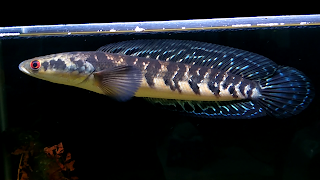When first brought home at 3" July 17
10" Aug 18
Kalimantan Flaring
Kalimantan is perhaps the most beautiful Channa Marulioides that I've kept. The part I love most about kali is thier band, yes they have lots of them almost looking like Channa Asiatica. The band extend to the belly. And they possessed strong colors when kept in the right PH. They are bold and always ready to show their best. When you approach the tank they will flare and show their colors.
The only shortfall of the Kalimantan is in the flower department, "usually" they dun have them much, but you'll have plenty of bands to ogle. The Batik pattern on all 3 fins are amazing, unfortunately not all the batik remains when kept from young. Plenty of work to groom retaining the batik to ensure they dont fade away.
Its ashame I've to sell my Kalimantan, but all good things must come to an end so that new fish can take its place. Thank you for following the progress of my Channa Marulioides var Kalimantan and hope you enjoyed the journey we had grooming this fish to be an excellent Champion.















Thanks for continuing to share so much about Channa Marus. Your website is the only updated website in English where I can find so much information and wisdom about them
ReplyDeleteWelcome...I'm glad you like it.
DeleteHow do you groom to retain the batik pattern on all the fins?
ReplyDeleteI notice not to over pump the fish helps to retain not only the batik but the bunga as well. But I do maintain low PH water all the time.
Delete